|
| |
Back to light
transports
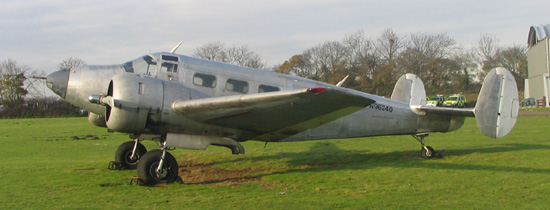 |
The Beech 18 first flew in January 1937, and
remained in production until 1969. It is powered by two 450hp Pratt
& Whitney R-985 radials. Seating seven plus two crew, it cruises at
220mph and has a range of 1,400 miles. It is 35 feet 2 inches long
and has a wing span of 49 feet 8 inches. Many were built for the
USAAF as the C-45 Expeditor; more than 9,000 were built in total.
This one was at North Weald in December 2005.
|
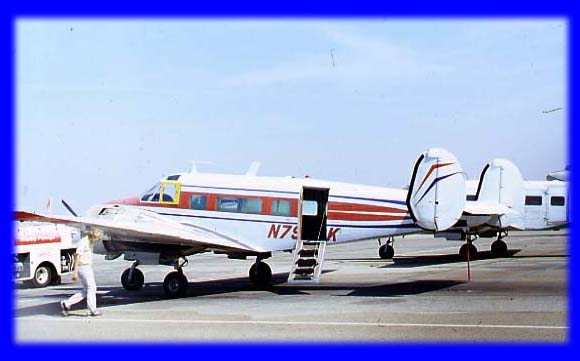 |
The Beech H18 is the last version of the
famous Beech 18 line, and is the one which remained in production
until the end of 1969. It differed principally from the earlier 18s
in having nosewheel undercarriage and a downward-folding entrance,
both shown here. The original Pratt & Whitney radial engines were
retained. Interestingly, this means that this venerable aircraft was
still in production at the same time as its successor's successor
(the Kingair, see below).
This one was seen at Fresno, California in
September 1981. |
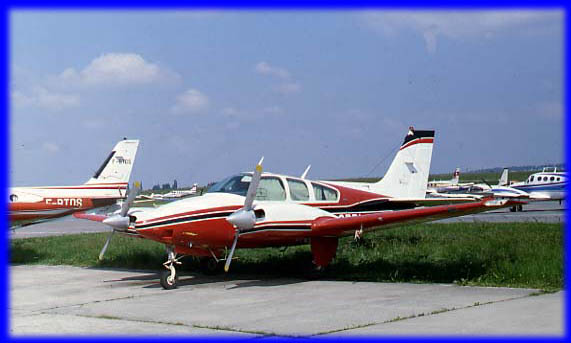 |
The Beech 55 Baron is one of the most elegant
twin-engined aircraft ever produced. It was introduced in November
1960 as a successor to the older Travel Air / Twin Bonanza series.
Several thousand have been built in several versions. Typically they
seat up to six people, and can cruise at up to 230 mph for 1,400
miles. Most Barons are also equipped to a very high standard of
avionics, making them expensive compared with competing Cessna 310s
and Piper Twin Comanches, but very popular for serious airway
flying. The US Army used several for training as the T-42 Cochise. This B55 was seen at Toussus,
France, in June 1979. |
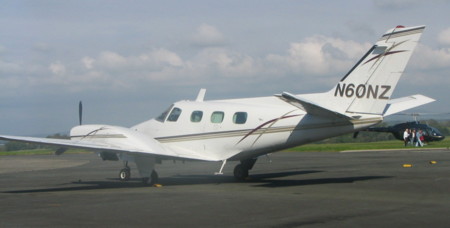 |
The Beech 60 Duke is a bigger and faster
aircraft than the Baron, but with similar capacity (six people.)
Unlike the Baron it is pressurised, so can fly up to 20,000 feet;
for which it also needs supercharged engines to operate in the rarer
atmosphere. It first flew in December 1966. Though very capable, it
has always been rather a niche aircraft, with just a few hundred
having been built. This one was at
Haverfordwest in September 2007. |
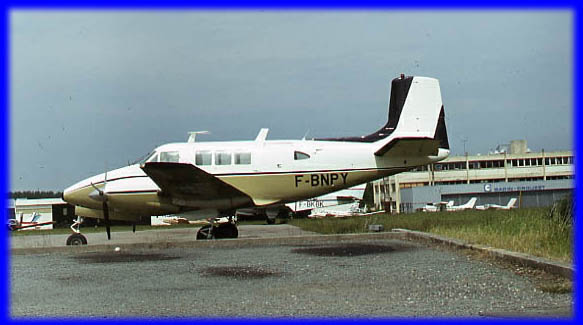
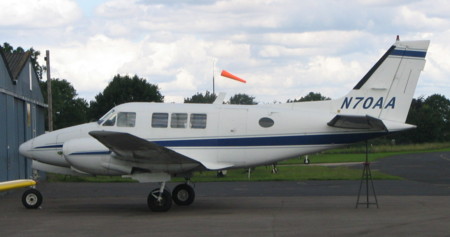 |
The Beech 65 Queenair first flew in August
1958, and was intended as a small commuter airliner or large
air-taxi, with accommodation for up to 9 people. It was, in effect,
the successor to the beech 18. It has been used by
various air forces as a communication aircraft, including the USAF
under the designation U-21 Ute. It is powered by two
380hp piston engines and has a cruising speed of 225mph and a range
of 1,550 miles. Early versions, such as
the top picture, at Toussus in May 1983, had the straight tail which
was typical of 1950s designs. Later versions, such as the lower
picture at Wellesbourne Mountford in July 2007, had a swept fin. |
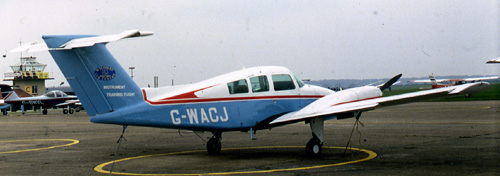 |
The Beech 76 Duchess is one of a crop of four
seat twins (others including the Piper Seminole and Grumman Cougar)
to emerge in the 1970s. It first flew in September 1974. The
fuselage is derived from the Sierra single. It is one of a small
number of Beech designs to have the T tail which became fashionable
about that time. Its two 180hp Lycoming O-360 engines gave it a
cruising speed of 180mph and range of 900 miles. It is 29 feet 1
inch long, with a wing span of 38 feet. Gross weight is 3,900lb. 437
were built.
High Wycombe, date unknown |
|
|
The Beech 100 Kingair started life as a
turboprop version of the Queenair, re-engined with Pratt & Whitney
PT6A turboprops. It first flew in January 1964 and was an instant
success. Constant development since then has ensured it remains the
benchmark executive turboprop even in 2005. Initial versions had the
model number Beech 90, but in 1969 a version was produced with a
longer fuselage (seating for up to 15 people depending on
configuration). Well over 1,000 have been sold and are in service
worldwide. It has served in the US air force as a trainer (T-44) and
a light transport (C-6). The top
photograph is of a Kingair used as a communications aircraft by the
Spanish air force, and seen at Luton. The lower picture is a typical
corporate example, pictured at Sywell in July 1976.
A further development, the Beech 200 Super
Kingair, is listed in the military
transports section (C-12).
|
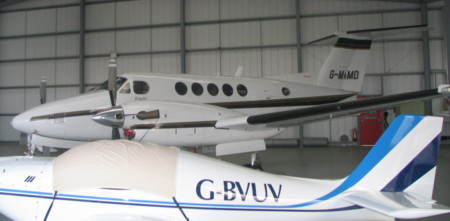 |
Beech 200 Super King Air
Gamston, November 2007 |
 |
The Beech 350 is the latest development in
the King Air line. First flown in 1988, it is stretched (length is
now 46 feet 8 inches, and wing span 57 feet 11 inches) to
accommodate up to 13 people plus two crew. Its two 1,050shp Pratt &
Whitney PT6 turboprops give it a cruising speed of 350 mph and range
of 2,300 miles. Gross weight is 15,000lb. So far (up to March 2006)
more than 220 have been delivered. This
one was at Davao,
August 2005 |
|
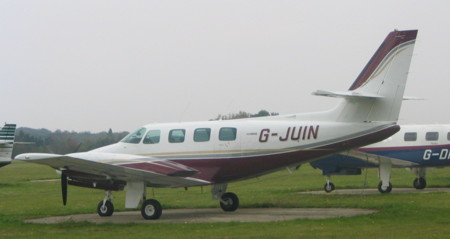 |
Like Beech, the Cessna aircraft company has
its headquarters in Wichita, Kansas. They have long specialised in
high performance light twin-engined aircraft. One of the latest is
the Cessna 303 Crusader, which first flew in February 1978 as a
replacement for the 310. Its two 250hp Continental TSIO520 engines
give it a cruising speed of 200mph and range of almost 1,200 miles.
it is a six seater with maximum gross weight of 5,150lb. It is 30
feet 5 inches long, with a wing span of 39 feet. 297 were built
before it succumbed to the general aviation depression in the 1980s.
This example
was seen at Denham in October 2007. |
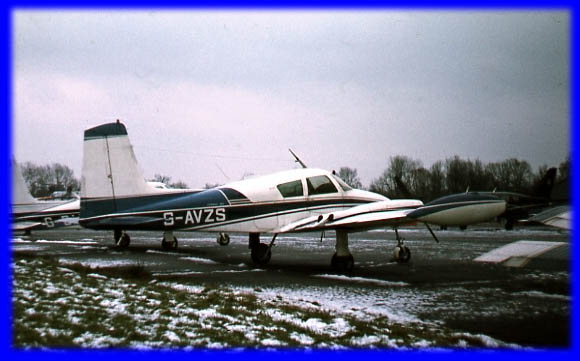
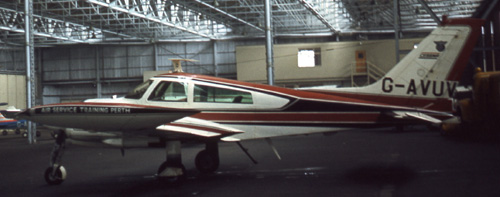
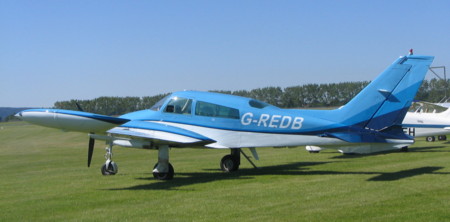 |
The Cessna 310 was one of Cessna's earliest
civil light twins. It first flew in January 1953. Early models had
the characteristic straight tail of the period, a swept fin being
introduced in 1960. Note the long-range fuel tanks on the end of the
wings, a Cessna trademark, giving it a range of 1,900 miles. With
two 285hp engines and able to cruise at up to 260 mph, the 310 is a
very capable aircraft of which several thousand have been built. The
US Air Force used a few, designated U-3 (formerly L-27).
Top: a venerable 310B seen in the snow at Elstree in December 1976.
Centre: Cessna 310N at Perth in April 1978. Bottom: Cessna 310Q,
Goodwood, August 2007. |
 |
The Cessna 320 Skyknight was a turbocharged,
five seat, high altitude development of the 310. It is readily
distinguished from the nearest 310 equivalent (the 310F) by the
extra side window. Launched in 1961, it was powered by two 260hp
Continental TSIO-470 engines, giving it a cruising speed of 245mph
and range of 850 miles. Just over 500 were built.
This one was undergoing maintenance at
Cranfield in August 2006. |
 |
The Cessna 337 Skymaster was an imaginative attempt to
solve the problem of assymetric thrust & drag experienced when a
twin-engined aircraft loses power in one engine. Sometimes, the
adverse yaw is very hard for a pilot to control. Not so with the
337, where both engines are mounted on the fuselage centreline,
almost like the German wartime Dornier Do335. It has quite
reasonable short field performance too. It can take six people at
220mph for up to 1,500 miles. Its main drawback is that it is very
noisy! Despite this, around 2,000 have been built, including many
for use by the US air force (designation O-2) who use it as a
lightly armed counter-insurgency aircraft.
This one was seen at Toussus in June 1979. |
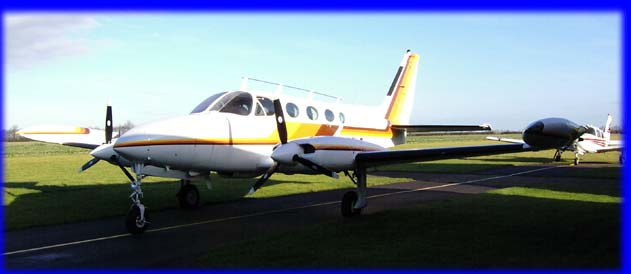 |
The Cessna 340 is a six seat pressurised
twin, in a similar class to the Beech Duke. Its two 310hp
Continental TSIO520 engines give it a cruising speed of 200mph and
range of 1,400 miles. It first flew in 1970. It is a robust machine,
34 feet 4 inches long with a wing span of 38 feet 1 inch. It is a
very popular machine, with about 1,290 built by the time production
ended. This one visited Top Farm in
Summer 2005. |
 |
Cessna 401
Wellesbourne Mountford, July 2007 |
 |
The Cessna 402 is one of Cessna's larger
light twins, being intended for up to 10 passengers or freight. It
is generally used as a highly capable load carrier. In the classic
twin trade-off between speed / payload / range, the 402 is a payload
specialist, in contrast to the 310 which is optimised for speed and
range; its range is adequate (up to 1,400 miles) but not
outstanding. This 402B was seen at Leeds
in September 1979. |
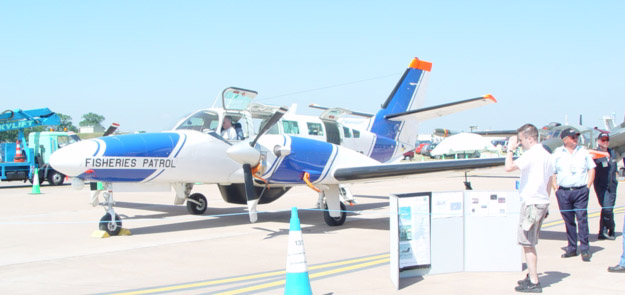 |
The Cessna F406 Caravan II is an interesting
hybrid machine, essentially comprising a 404 fuselage plus a 441
wing and two 500shp Pratt & Whitney Canada PT6A turboprops. It is
not strictly a Cessna at all, but is made by Reims Aviation in
France. It seats eight plus two crew. It first flew in 1983, since
when more than 90 have been made. It cruises at 265mph for a range
of 1,800 miles. it is a big machine 39 feet long and with a wing
span of 49 feet 6 inches.
It is popular with various government
agencies, as exemplified by this one operated by the Fisheries
Patrol, seen at Fairford, July 2005. |
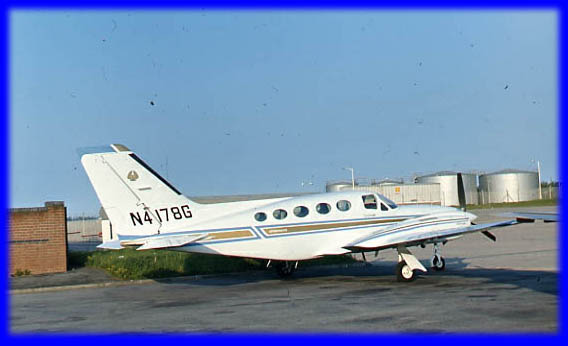 |
The Cessna 421 Golden Eagle is the top end of
Cessna's light twin range. It has a pressurised fuselage seating up
to 8 people, and can fly up to 1,700 miles at 270 mph. It is a
standard air-taxi or corporate aircraft for people who want
something bigger than a Piper Aztec but can't afford a Beech Kingair.
Its nearest real competitor is the Piper Navajo. Several hundred
have been built and are in service worldwide.
This one was at Luton in May 1978. |
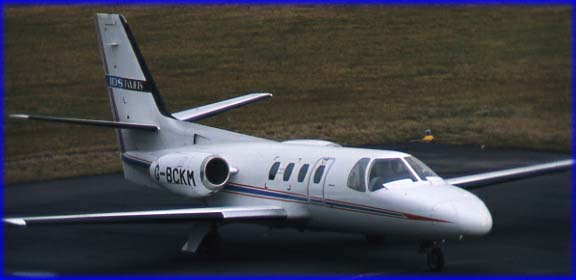 |
Cessna entered the executive jet business in
1968 with the announcement of the Cessna 500 Citation. It first flew
in September 1969, and had an entirely conventional layout. It was
originally intended for the `small and cheap' end of the executive
jet market, though many other versions have since been developed, of
progressively increasing capability. The Citation series is probably
the best selling range of executive jets in the world.
This very early Citation visited Newcastle in
February 1976. |
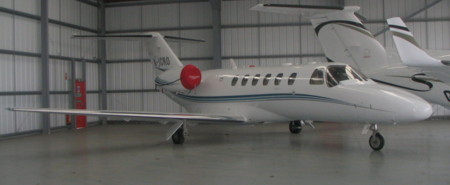 |
CitationJet
Gamston, November 2007 |
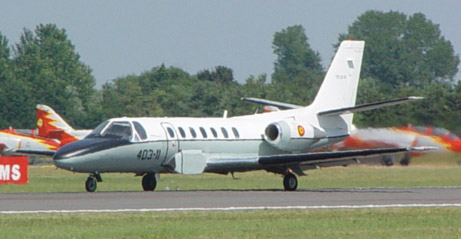 |
The Cessna 550 Citation II is a ten seat
executive jet, not counting the two crew. Its two 2,500lb Pratt &
Whitney Canada JT15 turofans give it a top speed of 460mph and range
of 2,000 miles. It first flew in January 1977; 733 were built. It is
47 feet 3 inches long, with a wing span of 52 feet 3 inches.
This one, operated by the Spanish air force,
was at Fairford in July 2005. |
 |
Cessna 560 Citation Ultra Encore
Gamston, November 2007 |
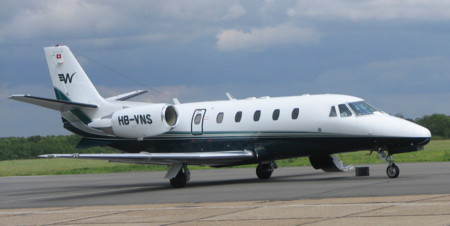 |
Cessna 560XL Citation Excel
Biggin Hill, July 2007 |
 |
The Cessna Caravan was designed partly to
replace the earlier Cessna 207 piston-engined utility aircraft, and
partly to take advantage of new rules permitting operation of single
engined aircraft on commercial night flights. It became an instant
success with small parcel carriers and on regular missions like
newspaper flights. It is cheap to operate and can handle short,
rough airstrips quite well. The US air force operate some under the
designation U-27. This one was
at Wellesbourne Mountford in July 2007. |





|